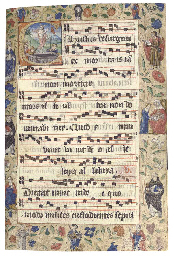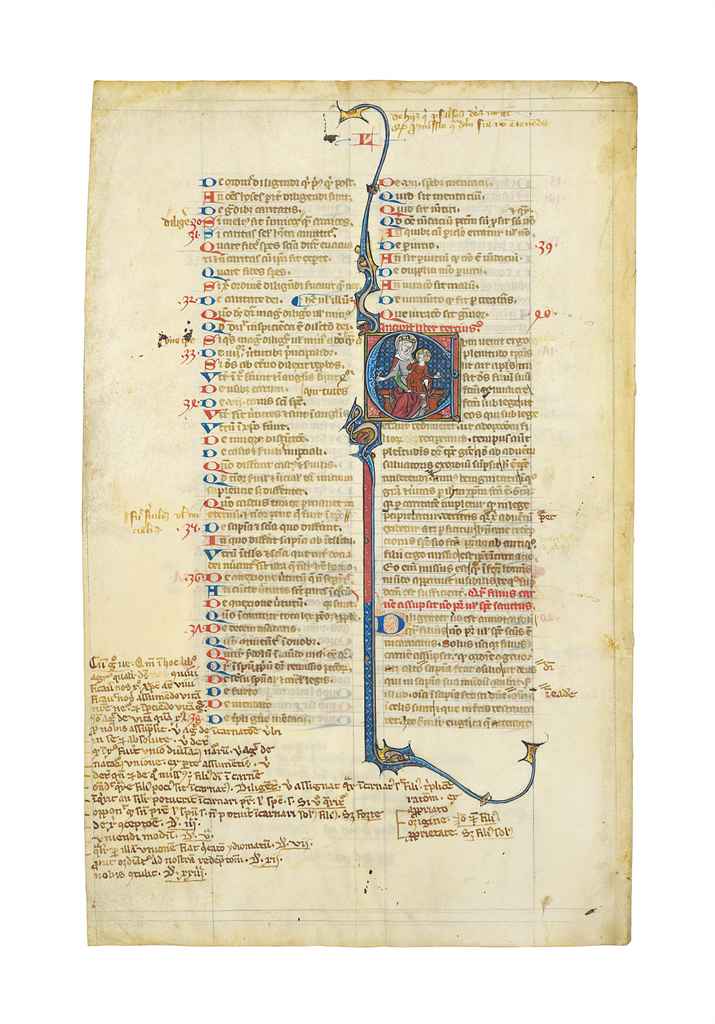THREE HISTORIATED INITIALS on two leaves from a Psalter-Hours, in Latin, ILLUMINATED MANUSCRIPT ON VELLUM
THREE HISTORIATED INITIALS on two leaves from a Psalter-Hours, in Latin, ILLUMINATED MANUSCRIPT ON VELLUM [?England, c.1260s] 176 x 127mm. 20 lines written in black ink in a gothic bookhand between two pairs of verticals and 21 horizontals ruled in plummet, one-line initials in alternate blue flourished in red and burnished gold flourished in blue, line-endings in blue and red, or blue, red and burnished gold, comprising dog-tooth and geometric patterns, disks, branching scrolls, and a FISH AND TWO GROTESQUE BEASTS in blue and red. The first leaf with HISTORIATED INITIAL 'E' on recto opening Psalm 54 ('Exaudi, Deus, orationem meam', continuing until verse 14) with the young David seated, holding a book with right hand raised, within stave of blue and red on burnished gold ground. The second leaf with HISTORIATED INITIAL 'I' on recto opening Psalm 99 ('Jubilate Deo, omnis terra') with a woman holding a book and with right hand outstretched, standing before a tower, a beast's head below, the verso with HISTORIATED INITIAL 'M' opening Psalm 100 ('Misericordiam et judicium'), with a man in blue robes bending down to pat a white dog, initial with stave of pink on burnished gold ground (both leaves slightly cropped, touching a beast's nose at outer edge, some flourishes and the bottom of the initial 'I'; initial M with man's face and dog rubbed). There is no agreement about where the parent manuscript was made. It is often attributed to England, and the line-endings compared with manuscripts such as the Grandisson Psalter and the Salvin Hours (British Library, Add. MSS. 21926 and 48985; see Nigel Morgan, Early Gothic Manuscripts II: 1250-1285 , London, 1988, nos. 165, 158), but there is no close English parallel for the style of the painted illumination. Alternate attributions include Flanders and the Rhineland, but the page layout, with each verse of the psalms starting on a new line (and therefore leaving line-endings free for decorative line-fillers) is not normal in these regions. It may perhaps be that both English and Continental artists collaborated on the manuscript. If enough leaves from the Hours of the Virgin or Office of the Dead could be located, it might be possible to identify their liturgical 'use' and settle the matter of the manuscript's origin definitively. From the published surviving leaves it is clear that it was a very early example of a Psalter-Hours, the hybrid that combined the texts of the Psalter and the Book of Hours, and effected the transition from one to the other as the most important book of personal devotion. Thirteenth-century Psalter-Hours are rare; Leroquais found only five examples in the Bibliothèque Nationale, for example ( Livres d'Heures, nos. 14, 15, 17, 61, 148, 187, 188). Because of its fragmentary nature the text and decorative programme of the manuscript has not been properly studied, and interesting features have previously gone unrecognised. One leaf, for example, has a prayer for 'our abbess', proving that the manuscript was made for a nun, and another prayer whose text strongly suggests that 'this holy convent' was Benedictine and dedicated to the Virgin Mary. Many initials depict Benedictine monks, but at least one depicts St Francis. The presence of an historiated initial for almost every Psalm, prayer, and other text is extraordinary: in this respect the manuscript recalls the twelfth-century St Albans and La-Charité-sur-Loire Psalters, now in Hildesheim and the British Library respectively. The modern pencil foliation places Psalm 12 at folio 54, but the eleven preceding psalms would have required no more than about twenty leaves: this suggests that in addition to a calendar, there may also have been a significant series of prefatory miniatures. Everything points to the manuscript having been made for an extremely wealthy nun, therefore probably from an aristocratic, or even royal, family. (2)
THREE HISTORIATED INITIALS on two leaves from a Psalter-Hours, in Latin, ILLUMINATED MANUSCRIPT ON VELLUM
THREE HISTORIATED INITIALS on two leaves from a Psalter-Hours, in Latin, ILLUMINATED MANUSCRIPT ON VELLUM [?England, c.1260s] 176 x 127mm. 20 lines written in black ink in a gothic bookhand between two pairs of verticals and 21 horizontals ruled in plummet, one-line initials in alternate blue flourished in red and burnished gold flourished in blue, line-endings in blue and red, or blue, red and burnished gold, comprising dog-tooth and geometric patterns, disks, branching scrolls, and a FISH AND TWO GROTESQUE BEASTS in blue and red. The first leaf with HISTORIATED INITIAL 'E' on recto opening Psalm 54 ('Exaudi, Deus, orationem meam', continuing until verse 14) with the young David seated, holding a book with right hand raised, within stave of blue and red on burnished gold ground. The second leaf with HISTORIATED INITIAL 'I' on recto opening Psalm 99 ('Jubilate Deo, omnis terra') with a woman holding a book and with right hand outstretched, standing before a tower, a beast's head below, the verso with HISTORIATED INITIAL 'M' opening Psalm 100 ('Misericordiam et judicium'), with a man in blue robes bending down to pat a white dog, initial with stave of pink on burnished gold ground (both leaves slightly cropped, touching a beast's nose at outer edge, some flourishes and the bottom of the initial 'I'; initial M with man's face and dog rubbed). There is no agreement about where the parent manuscript was made. It is often attributed to England, and the line-endings compared with manuscripts such as the Grandisson Psalter and the Salvin Hours (British Library, Add. MSS. 21926 and 48985; see Nigel Morgan, Early Gothic Manuscripts II: 1250-1285 , London, 1988, nos. 165, 158), but there is no close English parallel for the style of the painted illumination. Alternate attributions include Flanders and the Rhineland, but the page layout, with each verse of the psalms starting on a new line (and therefore leaving line-endings free for decorative line-fillers) is not normal in these regions. It may perhaps be that both English and Continental artists collaborated on the manuscript. If enough leaves from the Hours of the Virgin or Office of the Dead could be located, it might be possible to identify their liturgical 'use' and settle the matter of the manuscript's origin definitively. From the published surviving leaves it is clear that it was a very early example of a Psalter-Hours, the hybrid that combined the texts of the Psalter and the Book of Hours, and effected the transition from one to the other as the most important book of personal devotion. Thirteenth-century Psalter-Hours are rare; Leroquais found only five examples in the Bibliothèque Nationale, for example ( Livres d'Heures, nos. 14, 15, 17, 61, 148, 187, 188). Because of its fragmentary nature the text and decorative programme of the manuscript has not been properly studied, and interesting features have previously gone unrecognised. One leaf, for example, has a prayer for 'our abbess', proving that the manuscript was made for a nun, and another prayer whose text strongly suggests that 'this holy convent' was Benedictine and dedicated to the Virgin Mary. Many initials depict Benedictine monks, but at least one depicts St Francis. The presence of an historiated initial for almost every Psalm, prayer, and other text is extraordinary: in this respect the manuscript recalls the twelfth-century St Albans and La-Charité-sur-Loire Psalters, now in Hildesheim and the British Library respectively. The modern pencil foliation places Psalm 12 at folio 54, but the eleven preceding psalms would have required no more than about twenty leaves: this suggests that in addition to a calendar, there may also have been a significant series of prefatory miniatures. Everything points to the manuscript having been made for an extremely wealthy nun, therefore probably from an aristocratic, or even royal, family. (2)


.jpg)









Testen Sie LotSearch und seine Premium-Features 7 Tage - ohne Kosten!
Lassen Sie sich automatisch über neue Objekte in kommenden Auktionen benachrichtigen.
Suchauftrag anlegen